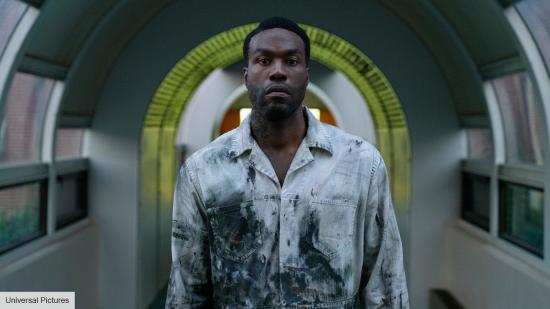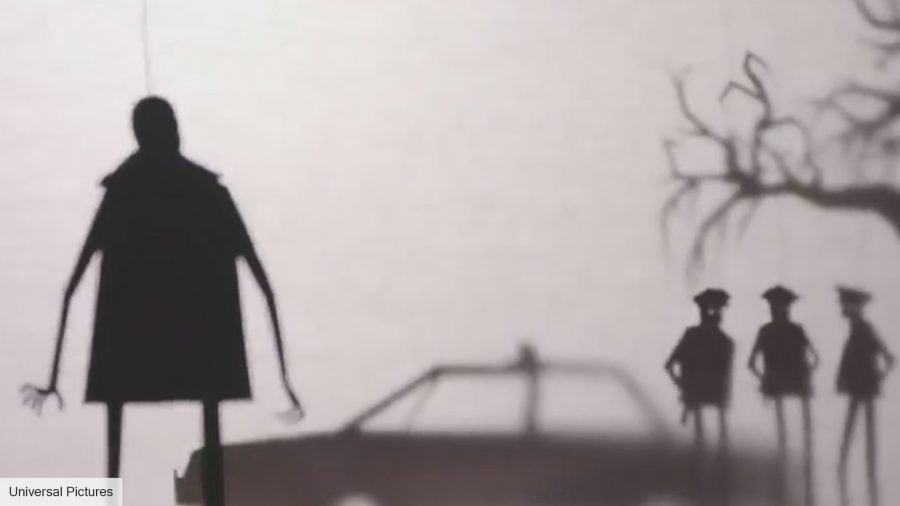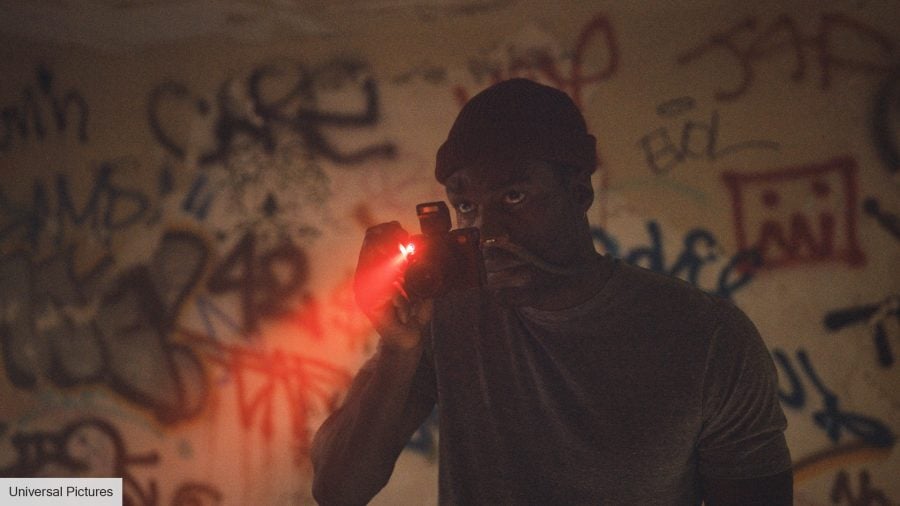Our Verdict
A politically relevant and powerful sequel to a cult classic movie, Candyman is a stunning punch to the gut.
Back in 1992 the first version of Candyman hit the big screen, telling a tale of wealth disparity and racial injustice behind a gritty graffiti-ridden backdrop. Now its 2021 sequel of the same name refines those same messages, modernises the original’s subtext, and delivers a gut punch of gore mixed with pointed social commentary.
Based on Clive Barker’s short story, The Forbidden, the horror movie is set in the urban landscape of Chicago, where the now gentrified “ghetto” has long been haunted by a vengeful spectre named Candyman. Say his name five times and the ghost will appear, gutting his victims in proper slasher fashion. In the original, we witnessed the hooked hand spirit terrorise the Black community, and ultimately saw a white university student Helen Lyle save the day, sacrificing herself in a fiery death to save a baby from Candyman’s clutches. The original’s ghost revenge logic was a bit lacking, for example, why would an angered ghost of a murdered slave predominantly target impoverished African Americans? And having a white protagonist for such a story was an iffy choice, to say the least.
Directed by Nia DaCosta, and co-written by she and Jordan Peele, the new movie addresses these questions brought up from the original and reframes the legend of Candyman from the perspective of a black couple as opposed to a white woman. The shift of focus results in a stylish sequel, and a very timely reboot that resonates with continuing issues of systemic racial injustice, gentrification, and America’s painful past.
Upcoming artist Anthony (Yahya Abdul-Mateen II), and his girlfriend Brianna (Teyonah Parris) move into Chicago’s now gentrified Cabrini Green neighbourhood, which 30 years ago were housing projects, and Candyman’s hunting grounds. After hearing the story of Helen Lyle from Brianna’s brother, Anthony begins to investigate their new neighbourhood – trying to find some artistic inspiration for a new exhibition. His digging leads him to some abandoned homes, being stung by a mysterious bee, and meeting Cabrini resident William (Colman Jason Domingo) who seems to know everything about the urban legend and Helen.

After hearing a story about an innocent man being beaten to death by the police, and learning more about the urban legend Anthony becomes obsessed. He creates a piece, daring people to “say his name”, and begins painting faceless figures everywhere. As more people start interacting with his work about Candyman, more people start dying. Anthony’s stung hand starts to rot, and slowly his reflection becomes unrecognisable.
Summon spirits: The best ghost movies
Nia DaCosta does a fabulous job at modernising Candyman; the gore, violent sequences, and general atmosphere are almost suffocating. Similarly, her art style is fascinating. Throughout the entire movie, there is the theme of gentrification, and how Black history, and communities are forgotten in its wake.
DaCosta takes the graffiti aesthetic from the original movie, and uses elegant paper cutouts for shadow art throughout the film. While looking sleeker, paper and shadows are also both fragile things, easily broken, and never permanent. Seeing the material used as a storytelling device adds a beautiful layer of meaning to her’s and Peele’s messaging.
It is really in these delicate details that Candyman’s political messaging hits hardest. The movie’s writing, while entertaining, does feel a bit on the nose at points, and its ending is overstuffed. The original Candyman didn’t explain the ghost’s logic; it simply gave a backstory and decided that he kills indiscriminately. In this new movie, Candyman’s existence is given profound meaning.
However, it is never fully unpacked or elegantly portrayed. In DaCosta’s sequel, Candyman is a collection of innocent people who have been murdered, pointing at the long-running violence against black men in America – as William in the movie says: “a pain like that lasts forever, that’s Candyman”.
Although the concept is immensely powerful, especially in light of the BLM movement, the movie feels rushed, as it struggles to explain this new take on the iconic ghost. The end result is some lengthy expositional dialogue, and a speedy climax that just doesn’t hit that satisfying narrative sweet spot.That being said, the fact that it is still in there is what makes Candyman stand as one of the best sequels or reboots I have seen in years. The movie pays homage to the original, honours its story, but also presents a new perspective on the OG’s script, building on the lore and unpacking its themes to deliver a socially relevant film.
The classics: The best movies of all time
Narrative faults also tend to be overshadowed by the mesmerising body horror in the movie, and the superb acting from the cast. Abdul-Mateen is captivating as Anthony, making us laugh, cry and grip our seats in suspense as he delves into the supernatural world that is Candyman. Similarly, Parris’ character journey from sceptic to a proactive fighter is superbly put together.
Candyman is no longer just a vengeful ghost; he is a deadly manifestation of the pain and rage against continued racial violence in America. In the original, he was simply Daniel, and now in the reboot, he is all the fallen victims of systematic murder – a hive of tortured souls, if you will. Although the messaging gets a bit on the nose towards the end, like a scene with a cop giving a sinister soliloquy about how the legal system abuses black citizens, the film’s message still hits you square across the face.
Reboots usually recycle ideas, and seldom do they improve upon their source material, but from its writing to its cinematography Candyman has never looked better.


